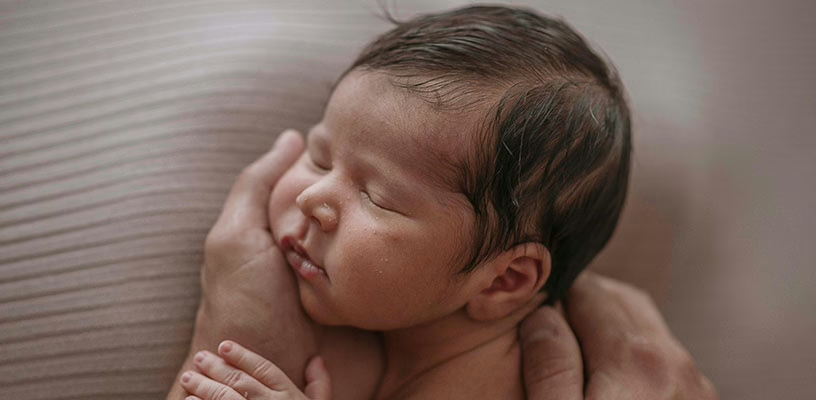Your Baby’s Soft Spots: Care, Injuries, and What’s Normal
If you’re a new parent, you’re probably scanning every part of your baby 24/7 to make sure nothing’s wrong. It makes perfect sense if you’re wondering what those soft spots on her head are all about.

Soft spots, also called fontanelles, are the spaces between the bones of your baby’s skull. They’re not as fragile as they seem, and they serve a couple of very important purposes. Let’s break down all you need to know about your baby’s fontanelles.
What exactly are fontanelles?
Your baby’s skull isn’t one solid piece of bone. Instead, it’s made up of several plates connected by flexible tissue. The fontanelles are the gaps where these plates meet.
Most babies have two major fontanelles:
- Anterior fontanelle: This is the larger, diamond-shaped soft spot located on the top of your baby’s head. It may measure anywhere from about half a centimeter to three centimeters wide.
- Posterior fontanelle: The smaller, triangle-shaped soft spot found at the back of your baby’s head, usually around half a centimeter in size.
There are other, smaller fontanelles, but they’re usually not as noticeable. One exception is the third fontanelle—it isn’t present in all babies, but when it is, it’s located just in front of the posterior one. It’s often found in children with certain health conditions, including (but not limited to) Down syndrome and congenital rubella. 1
Why do babies have soft spots?
Soft spots aren’t random. They serve two key functions:
- Facilitating birth: During a vaginal delivery, the skull plates can compress and overlap, making it easier for your baby’s head to pass through the birth canal. This compression is why some newborns have cone-shaped heads right after birth, which usually resolves within the first few weeks of life. 2
- Allowing for brain growth: In the first year of life, your baby’s brain grows rapidly, and the fontanelles give her skull the space it needs to expand.
When do soft spots close?
The timing of when babies’ fontanelles close varies, but here’s a general timeline:
- Posterior fontanelle: This smaller soft spot typically closes first, often in your baby’s first 6 to 8 weeks. 1
- Anterior fontanelle: The larger soft spot on top of the head usually closes much later, when your baby is between 7 months and 19 months old. 3
Keep in mind that these are just averages. Some babies may have their soft spots close a bit earlier or later.
Male babies’ soft spots tend to close before those of females, and preemies may experience a delay in closure. Your pediatrician will monitor your baby’s fontanelles during routine checkups. 1 4
Can you touch a baby’s soft spot?
It’s natural to feel nervous about touching your baby’s soft spots, but rest assured, they’re more durable than you might think. 5 A thick membrane between your baby’s skull bones protects her brain, so if you handle her normally, it won’t do her any harm. 6
You can touch and wash your baby’s head as usual. Just keep supporting her head and neck. The most important thing to avoid is bumps on the head, since the membrane of her fontanelles isn’t as strong as bone.
When a soft spot signals a problem
While soft spots are normal, changes in their appearance can sometimes indicate an issue. Here’s what to look out for:
Sunken fontanelles
A healthy fontanelle should be firm and curved slightly inward, but mostly aligned with the plates of your baby’s skull. If it appears sunken, like a divot, it could be a sign that she’s dehydrated.
Other signs of dehydration to watch for include: 7
- Fewer wet diapers than usual (going more than 6 hours without producing one)
- Darker, stronger-smelling urine
- Sunken eyes
- Dry mouth and lips
- Lack of tears when crying (although newborns may not produce tears in their first weeks) 8
- Excessive sleepiness or fussiness
If you notice a sunken fontanelle, especially with other dehydration symptoms, contact your pediatrician right away.
Bulging fontanelles
A bulging fontanelle may be a sign of increased pressure inside the skull, which can indicate a problem. However, there are other (innocent) explanations, so before you worry too much, rule them out.
Normal bulging occurs when your baby is crying or lying down. This type of bulging disappears when she’s calm and sitting up.
If you notice a bulging fontanelle when your baby isn’t crying or lying down, it can be a sign of a serious condition, such as: 3
- Fluid buildup (hydrocephalus)
- Infections like encephalitis or meningitis
- Other conditions causing increased cranial pressure
- Bleeding in the brain 9
Make sure your baby’s calm, sit her up, and contact 911 immediately if her bulging fontanelle doesn’t return to normal.
Injury to the soft spot
If your baby bumps or hits her soft spot or any other part of her head, watch for these signs of a head injury: 10
- Head swelling / bulging fontanelles
- Bruising around eyes or ears (a possible sign of fracture) 11
- Vomiting
- Seizures
Your baby may also show more subtle signs of head trauma, including: 12
- Nonstop crying
- Refusal to feed
- Difficulty waking up
- Regression of new skills
If your baby shows signs of a head injury, call 911 and seek emergency medical attention right away.
Pulsating fontanelles are nothing to worry about
Your baby’s soft spots pulse in time with her heartbeat, so this is completely normal to see. This is different from a bulging fontanelle, which doesn’t move. 5
Early or late closure
Premature (or late) closure of the soft spots can be associated with certain conditions, like Down syndrome or congenital hypothyroidism. 13 The same goes for a larger-than-average soft spot.
As you’ve probably picked up by now, if anything about your baby’s fontanelles seems at odds with what you were expecting, the right move is to get her seen by a pediatrician. It could be normal variation, but it could also indicate a problem, and it’s almost never a bad idea to get a professional’s input.
Keep track of its appearance or changes in your gallery or a baby tracker app. Some of the best baby trackers offer dedicated journal features with notes and pictures.
Are babies ever born without soft spots?
Some babies are born with their fontanelles already closed—a condition known as craniosynostosis. This can cause your baby’s skull to grow abnormally and end up misshapen, and in some cases, may leave her brain without enough room to grow.
Your doctor will be able to spot this soon after your baby is born, and you can also look out for signs such as: 14
- No soft spots on your baby’s skull
- Slow growth or no growth in your baby’s head over time
Fortunately, you can treat many cases of craniosynostosis with a special medical helmet that molds your baby’s head. Sometimes, however, she may need surgery, depending on the extent of her condition.
Either way, try not to panic. Many children with craniosynostosis have perfectly healthy childhoods, although you’ll need to get your baby checked out regularly to confirm that her brain and skull are developing correctly. 14
Final thoughts
You should always take care to support your baby’s head and neck, but her soft spots don’t need special treatment. So long as you do your best to avoid bumps to the head and keep an eye on her fontanelles to make sure they’re not closing too soon, you probably don’t have anything to worry about.
You can always take your baby to her pediatrician if you’re concerned about her soft spots. Otherwise, just try not to fret. Before you know it, they’ll close up and become another memory of these early days with your bundle of joy.
Article Sources
- StatPearls. "Anatomy, Head and Neck: Fontanelles" Retrieved August 27, 2025.
- Morehouse School of Medicine. "Here’s When Your Baby’s Soft Spot Will Close and Finally Stop Pulsing" Retrieved August 27, 2025.
- MedlinePlus. "Fontanelles - bulging" Retrieved August 27, 2025.
- Children’s Hospital Colorado. "Anterior and Posterior Fontanelle Closures" Retrieved August 27, 2025.
- HealthyChildren.org. "Your Baby's Head" Retrieved August 27, 2025.
- UF Health. "Fontanelles - Sunken" Retrieved August 27, 2025.
- Harvard Health Publishing. "Symptoms of dehydration: What they are and what to do if you experience them" Retrieved August 27, 2025.
- Children's Hospital of Philadelphia. "Newborn Crying" Retrieved August 27, 2025.
- University of Rochester Medical Center. "Intraventricular Hemorrhage in Babies" Retrieved August 27, 2025.
- Johns Hopkins Medicine. "Head Injury in Children" Retrieved August 27, 2025.
- Nationwide Children’s. "What to Know (and Do) About Bruises" Retrieved August 27, 2025.
- New York State Department of Health. "Traumatic Brain Injury Prevention, Children Ages Birth to 19 Years" Retrieved August 27, 2025.
- MedlinePlus. "Sutures - separated" Retrieved August 27, 2025.
- Centers for Disease Control and Prevention. "Craniosynostosis" Retrieved August 27, 2025.






